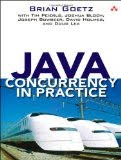Below is a a short comparative review of tow books about Java concurrency which I’ve read in the last couple of months. Disclaier: the Amazon links are affiliate ones.
Java Concurrency in Practice is an interesting book, which should be a must-read for anyone doing concurrent programming in Java (and in these days if you aren’t, you’re missing out on a whole lot of possible performance improvement). While some reader criticize it for the dense stile, it is hard to see how one could tackle such a complicated topic in simpler way (to paraphrase Albert Einstein: one needs to make things as simple as they need to be and no simpler). That said, the book definitely has the topics ordered from simple to more advanced, so even if you find the idea of reading the whole book daunting, you should look at the first couple of chapters at least. I would especially recommend chapter 3 (Sharing Objects) from part I (Fundementals) which should give a clear motive to everyone why they should be concerned by thread-safety and how they should reason about concurrent programs (I find that many concurrency errors occur because people have a naive and simplistic understanding of the way concurrency works on modern hardware).
Concurrent Programming in Java: Design Principles and Pattern (2nd Edition): The CPiJ book is much older, ancient even by computer age standards (published in 1999, compared to the JCiP book published in 2006). If also describes a much more manual, tedious way of doing things compared to the newer book. Also, it talks about the precursor of the java.util.concurrent package, since the package didn’t exists back then. All in all: if possible, get the JCiP book. If you already have the CPiJ book, it is a good introduction to the topic, however be ware that much of the advice is outdated and Java 6 (and even Java 5) contain better and simpler ways to perform the tasks described in the book.

